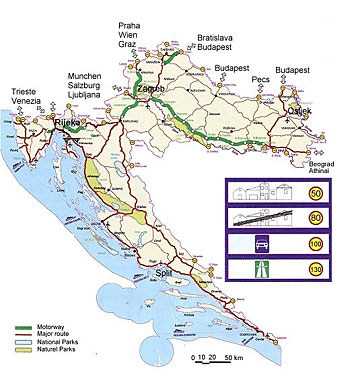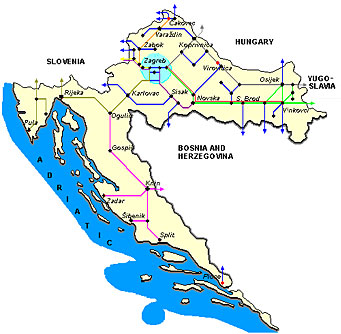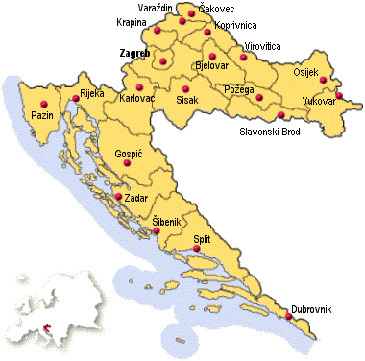
About Croatia
Economic sectors
Tourism: Croatia offers various forms of tourism, with the Adriatic coast and islands, scuba diving, hunting and fishing, health tourism with 19 sea and mainland resorts, yachting with more than 40 marinas and 15,000 berths etc.
Industry: In Croatia industry accounts for about one-fifth of the GNP and employs about one-quarter of the labour force. The largest sectors within industry in terms of production are: electrical engineering, food processing, chemicals, pharmaceuticals, textiles, wood processing, manufacture of machines and devices, shipbuilding and telecommunications equipment. Industrial exports make up about 97% of total Croatian commodity export.
Agriculture and food production: Agriculture plays an important role in Croatian economy. Together with forestry and fishing, agriculture accounts for about 8% of the GDP and employs approximately 6% of Croatian workforce. About 40% of the Croatian population live in the countryside, and about 70% of the agricultural land is owned by private farmers, with the balance owned by the state. Generally, Croatian agriculture could be self-sufficient.
Construction: Construction accounts for about 5% of the GNP in Croatia, and employs about 7% of the workforce.
Transport and Telecommunications: Transport and telecommunications sectors account for about 8% of the GDP and were also strongly affected by the war and the closing of borders.
The telecommunications network in Croatia is maintained by the Croatian Telecom, 51% owned by the Deutsche Telekom. There are also two mobile network operators: Cronet and VIPnet.
There are twelve free trade zones in Croatia. Besides the usual exemption from the tax and duty on all goods produced within the zone and destined for export, the users of the zone who invest in its infrastructure more than EUR 130,000 are exempt from the company tax for five years. Other users of the zone pay the corporate profit tax at 50% of the standard rate.
Gross Domestic Product: The GDP in the year 2000 was 19.03 billion USD, or 4255 USD per capita. Expressed in Croatian kunas or the currencies of the European Monetary Union, this is an increase by significant 3.8% (Because of the extremely high increase in the value of American dollar, the GDP and GDP per capita expressed in U.S. dollars showed decrease).
Inflation: In the last five years of the 1990s, Croatia was successful in maintaining the prices and exchange rate stability primarily owing to the tight and restrictive monetary policy. However, in the year 2000 the inflation was 6.2%.
Foreign debt: At the close of the year 2000, the foreign debt of Croatia amounted to about USD 10.8, or about 57% of the GDP realised during the same year. The debt in the ten months of the year 2001 amounted to USD 11.2 and it is estimated that its ratio to the GDP will remain the same.
The major trade partners per destination of the Croatian exports are Italy (USD 1104 million), Germany (689), Bosnia and Herzegovina (560), Slovenia (426) and Austria (268); and the major trade partners per source of the Croatian imports are Germany (USD 1547 million ), Italy, (1524), Slovenia (712), Russia (654) and Austria (631).
The establishment of a business incentive surrounding, in co-ordnance with the standards which prevail in the EU and countries with expanded market economies, is one of the primary aims of the economic policy of the Government of the Republic of Croatia.
Media: Public Television and Radio Station (HRT),
two private nation-wide television station,
10 regional stations.
Daily newspapers Vecernji List, Jutarnji List, Vjesnik, Slobodna Dalmcija, Novi List.
Weekly newspapers Globus, Nacional, Feral Tribune, Fokus.
GDP: 2002: EUR 23.8 billion (+ 5.2% on 2002)
Per-capita GDP: EUR 5,362
Exchange rate: EUR 1 = HRK 7.563; HRK 1 = EUR 0.132 (2003 figures)
Further reading:
Croatian Chamber of Economy
Croatian Bureau of Statistics
Croatian National Bank
Ministry of Finance
Zagreb Stock Exchange

How to reach Croatia
TRAVELLING DOCUMENTS
Passport: To enter Croatia you need a valid identity card or passport depending on international agreement between countries.
Visa: Entry visas for Croatia are issued by the embassies and consulates of the Republic of Croatia. Only in exceptional cases can visas be obtained at the Croatia's international border crossings.
Children must be registered in the passport of one of their parents or have their own passport. The loss of the passport or any other identification document must be immediately reported to the nearest police office. They will issue an official notification of the loss in order to enable you to obtain a new travel document.
Customs formalities
There are no customs fees for personal belongings. Foreign currency can be imported and exported freely. Expensive professional and technical equipment should be declared at the border crossing.
TRAVELLING BY PLANE

From almost all international airports you have scheduled flights to the capital Zagreb, where you can transfer to inland flights. Croatia Airlines and several international airliners fly to Zagreb daily. During the peak season, the number of flights is increased and a number of charter flights are offered to the most important tourist destinations of the country directly: Pula, Rijeka, Split, Brac and Dubrovnik.
Croatia Airlines has scheduled international flights for: Amsterdam, Berlin, Bruxelles, Duesseldorf, Frankfurt, London, Madrid, Milan, Moscow, Munich, Paris, Prague, Tel Aviv, Rome, Sarajevo, Skopje, Vienna, Lisbon, Zurich and Manchester (during the tourist season) Regular Domestic Flights:Brac, Dubrovnik, Pula, Split, Zadar Information: (tel.) 0800 7777, 481 96 33
Reservation: (tel.) 062 777 777, 487 27 27.
Other airline companies that have scheduled flights for Croatia:
Aeroflot, Air Bosna, Alitalia, Australian Airlines, Air France, Avioimpex, British Airways, Crossair, ESA, Lufthansa, LOT, Malev, Turkish airlines
Airports in Croatia:
Split, Zagreb,Rijeka,Dubrovnik,Pula, Osijek,Brač,Zadar.
TRAVELLING BY CAR

Coming from central Europe, you can reach some of the coast destinations faster by car than by train. During the summer months traffic at the borders is a bit heavier, and that can cause some delay. To enter and drive in Croatia, you will require a green insurance card and valid national or international driving permit.
Fuel: Petrol stations in big towns and cities as well as on important roads are open non-stop, otherwise the working hours are from 6:00 a.m. to 8:00 p.m. Lead-free petrol is available on all petrol stations and it is called bezolovni (green label). In July and August news and traffic information are broadcast in English and German regularly on main Croatian broadcast stations. A toll is
payable on motorways.
Regulations: Traffic drives on the right. Speed limits are 130kph (81mph) on motorways, 100kph (62mph) on dual carriageways, 50kph (31mph) in built-up areas and 80kph (50mph) outside built-up areas. The amount of the fine depends on the extent of the infraction committed. Blood/alcohol limit is 0.5 ppm.
Accidents must be reported to the police (Policija) immediately. Police emergency number is 92.
Croatian Auto Club, HAK (Hrvatski Auto Klub) works together with other international automobile clubs.
HAK, Draškoviceva 25, 10000 Zagreb, tel: 01 4554 433, fax. 01 448 630.
Road service of the HAK is available by dialling 987.
TRAVELLING BY TRAIN

There is a railway network connecting all major Croatian cities except Dubrovnik. There are direct lines to Slovenia, Hungary, Italy, Austria, Switzerland, Slovakia, France, Germany, Bosnia-Herzegovina and Yugoslavia. There are indirect lines to almost all other European countries.
Timings from, for example, Munich to Rijeka, is about 9 hours and to Pula 13 hours. Count on about 5 hours for trains from Vienna.
The types of train services that operate in Croatia are the following: EuroCity (EC), InterCity (IC), express (Ex), fast (B), local and accelerated trains.
Eurocity and Intercity:
· EC "Mimara": Berlin - Leipzig - Munchen - Salzburg - Ljubljana - Zagreb;
· IC "Croatia": Wienna - Maribor - Zagreb;
· IC "Kvarner": Budapest - Zagreb - Rijeka;
· IC "Drava": Budapest - Cakovec - Ljubljana - Venice
Main Railway Station in Zagreb,
Information, tel. 060 333 444
International lines, tel. +385 1 4573 283






